You might have seen the enormous Budweiser Clydesdales on tv, but there are many other breeds of enormous horses around the world today. These heavy animals are called draft horses, and were traditionally used for agricultural work before the advent of mechanized farming. Here are 15 of the largest horse breeds in the world.
Table of Contents
15. Russian Draft
Country of Origin: Russia
Height: 14.2 – 15 hands
Weight: 1,280 – 1,550 pounds
Common Colors: Bay, chestnut, strawberry roan
The Russian Draft (Russian Ardennes, Russian Heavy Draft) is not as heavy as some other draft breeds. Compact and muscular, these horses were originally bred for farm work. They have lively gaits, and also made suitable carriage and military horses.
Today, the Russian Draft is mostly bred for milk and meat. Mares can produce well over 2500kg over a lactation period (6 or 7 months), and this is used to make a fermented milk drink called kumis.
14. Italian Heavy Draft
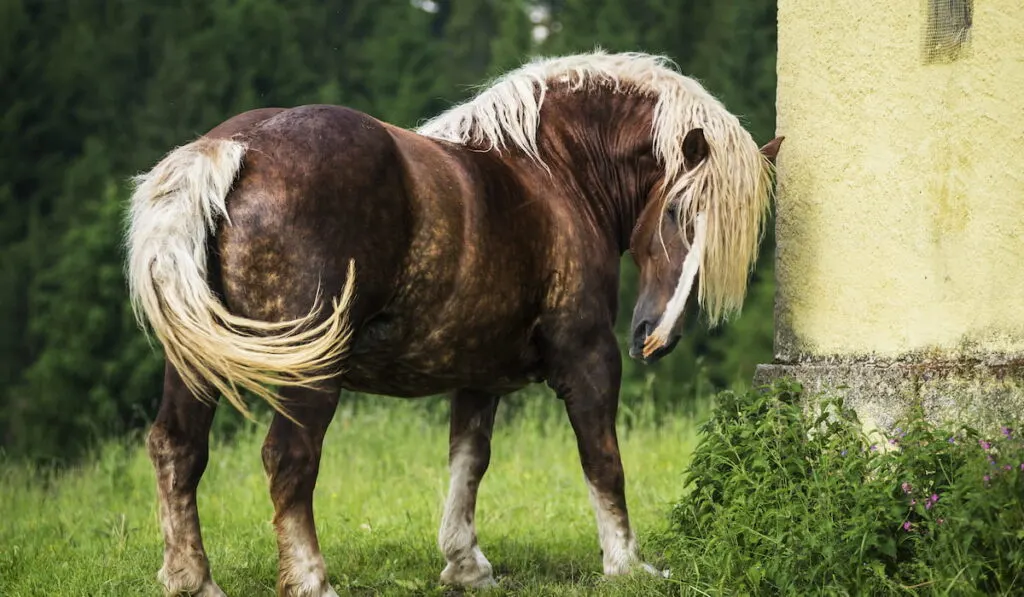
Country of Origin: Italy
Height: 14.2 – 15.3 hands
Weight: 1,320 – 1,540 pounds
Common Colors: Chestnut
These broad, heavy horses from Italy closely resemble the French Bretons. They also bear a resemblance to the popular Haflinger horse, although they are much heavier. Like most draft horses, the Italian Draft began as a farm horse – but Italian farmers needed an animal with more speed and agility than the heavy agricultural workers of the time.
Breeders added more Percheron and Boulonnais horses to the breed, and the result was a relatively small yet strong and agile draft horse suited for small farming.
Today, due to the mechanization of agricultural processes, they are mostly raised for their meat.
13. Boulonnais
Country of Origin: France
Height: 14.3 – 16.3 hands
Weight: 1,250 – 1,650 pounds
Common Colors: Usually gray, but sometimes chestnut or black
Also known as the “White Marble Horse” and “Europe’s noblest draft horse”, these fine animals are large, strong, but have an elegant way of moving. They are mostly used in their native homeland of France, where they’ve been pulling carts and providing meat to the people of Normandy for hundreds of years.
A smaller type of Boulonnais known as the Mareyeuse was used for transporting fish between Boulogne to Paris – a 200-mile trip completed in less than 18 hours. This journey is commemorated with the Route du Poisson – a relay-style race held every year.
12. Jutland
Country of Origin: Denmark
Height: 15 – 16.1 hands
Weight: 1,430 – 1,760 pounds
Common Colors: Chestnut
Jutland horses are selectively bred for their striking chestnut color and compact, muscular bodies.
Best known today as the stocky horses that pull the Carlsberg beer wagons in Copenhagen, Jutlands are a source of Danish national pride. They appear in old Danish folk tales, and there is some evidence to indicate that their ancestors were first ridden and used by Vikings in the 9th century.
11. Dutch Draft
Country of Origin: The Netherlands
Height: 15 – 16 hands
Weight: 1,500 – 1,800 pounds
Common Colors: Chestnut, bay, gray, sometimes black
Before the advent of mechanized farming, the heavy Dutch Draft was used primarily for agricultural work in the Netherlands. They are built similarly to the Belgian, Ardennes, and Brabant – thickly built all over, with a strong neck and chest.
While Dutch Draft horses are quite rare (especially outside of the Netherlands) they are still used for light farm work and in competition.
10. American Cream Draft
Country of Origin: United States
Height: 15 —16.5 hands
Weight: 1,250 – 1,800 pounds
Common Colors: Cream – light, medium, or dark
These striking horses have an elegant way of moving and a unique coat color. Unlike other “color breeds,” the American Cream Draft is genetically distinct from its other draft breed cousins.
The breed began in Iowa in 1911 with a single cream-colored mare named Old Granny. Over 98% of American Creams can trace their lineage back to this mare.
American Creams are suitable for carriage work, performances, and can even be used under saddle in dressage. Despite their heavy stature, they have a light and elegant way of moving.
9. Breton
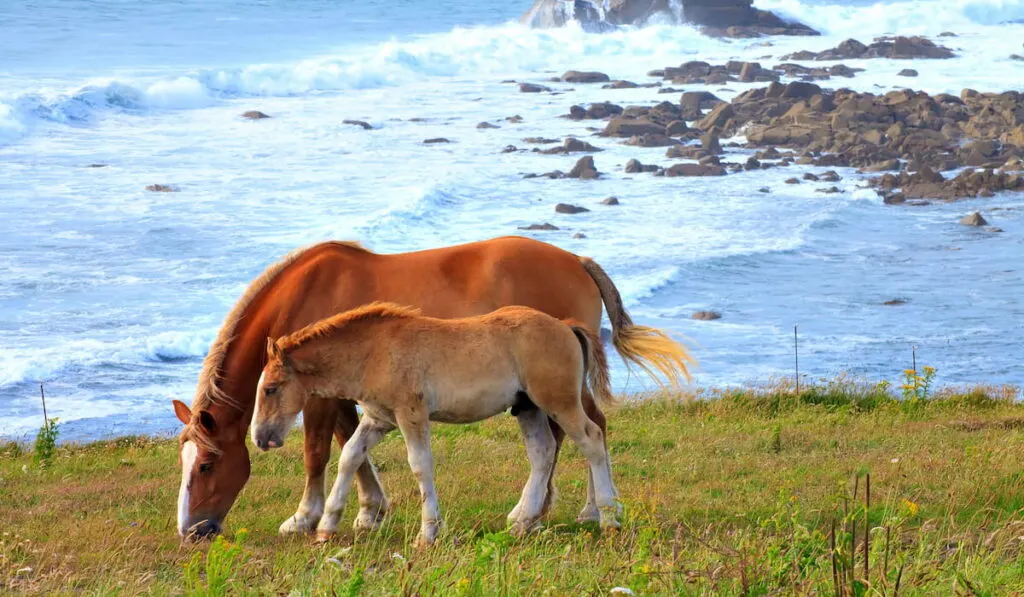
Country of Origin: France
Height: 15 – 16 hands
Weight: 1,500 – 1,800 pounds
Common Colors: Chestnut, bay, gray, roan
Like other draft breeds in France, the Breton comes from a long line of hardworking draft horses in Brittany, France. There are three separate types of Breton horses – the smaller Corlay Breton (for riding and driving), the Postier Breton (for light farm work), and the Heavy Draft Breton (for heavy farm work).
In years past, the Breton was used by the military and for agricultural work. Today, they are still versatile horses that are used for many things, but they are also bred for meat.
8. North American Spotted Draft
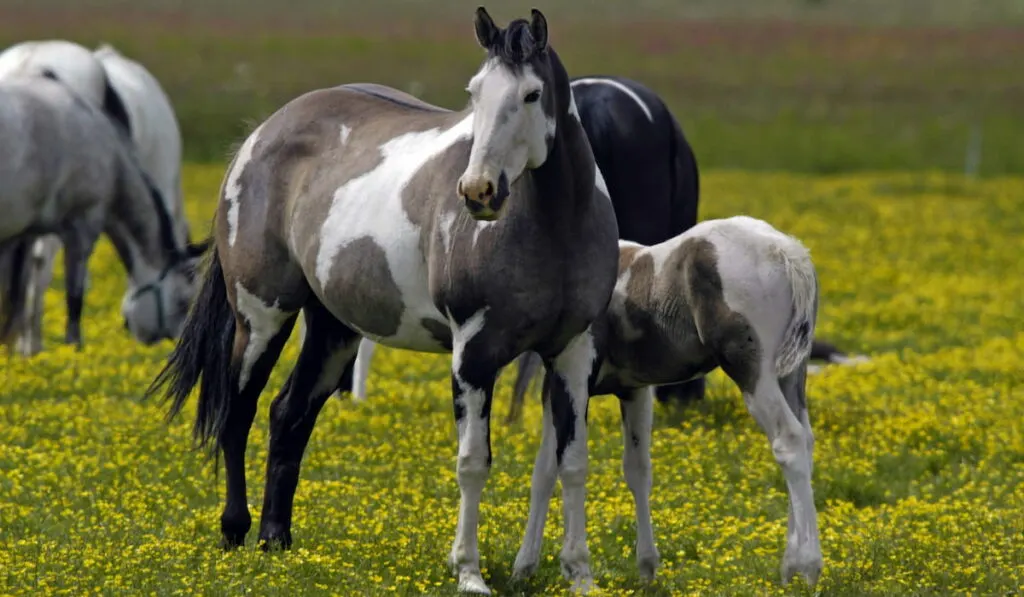
Country of Origin: United States
Height: 15 – 17 hands
Weight: 1,250 – 2,000 pounds
Common Colors: Must have pinto coloring but most are black and white, bay and white, or sorrel and white
The Spotted Draft horse is a flashy carriage horse that is commonly used in performances, on working farms, or as a pleasure horse. They represent a mixture of many different draft breeds, including the Percheron, Clydesdale, Shire, Suffolk Punch, Belgian, or North American Cream Draft.
However, to be registered as a Spotted Draft Horse, they must display pinto coloring – those flashy patches of white splashed across a dark body (or vice versa). Because the breed is fairly new and focused on color, there are a few different classes of Spotted Draft horses – Premium, Regular, Breeding Stock, and Indexed
Premium horses cannot contain any gaited horse, Saddlebred, Appaloosa, or Gypsy Vanner blood. However, horses may be registered as Spotted Drafts if they have an unknown pedigree, as long as they display the distinctive pinto coloring and other draft horse qualities.
7. Suffolk Punch
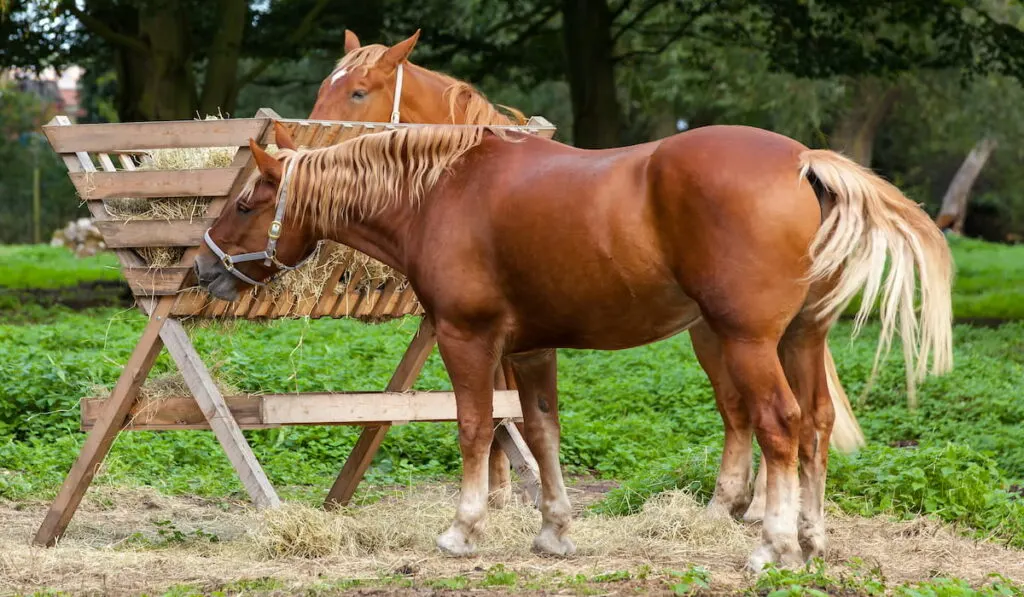
Country of Origin: England
Height: 16.1 – 17 hands
Weight: 1,500 – 2,000 pounds
Common Colors: Chestnut
The term Suffolk Punch was coined from the old “Punch-and-Judy” puppet shows of the early 1800s. “Punch was a short, squat, chubby fellow, and his name came to describe any short, fat man or anything thick.” The Suffolk punch is a thick, heavy horse that hails from Suffolk, England – so the name stuck.
These horses are friendly easy-keepers, and are known for their good temperaments and longevity. Because most Suffolk Punch horses stayed local to the area on small working farms, the breed looks a lot like it did over 200 years ago. Nearly all Suffolk punches can trace their lineage back to a single horse born in 1768 named “Thomas Crispin’s horse.”
6. Ardennes
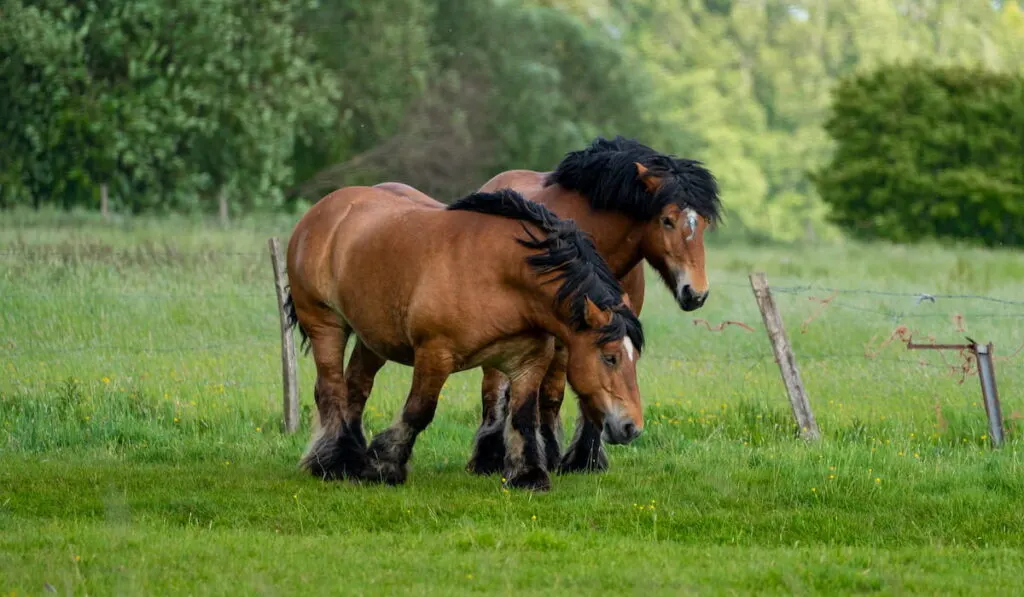
Country of Origin: France, Belgium
Height: 15 – 16 hands
Weight: 1,500 – 2,200 pounds
Common Colors: Bay, roan, chestnut, palomino, gray
The ancient Ardennes is descended from heavy warhorses used in Ancient Rome. These strong horses have been used for hundreds of years for heavy agricultural work, and they served as artillery horses during the French Revolution.
While the Ardennes horse is not a popular breed in the United States, they are still used today in Europe thanks to their surprisingly agile movement and docile temperaments.
5. Percheron
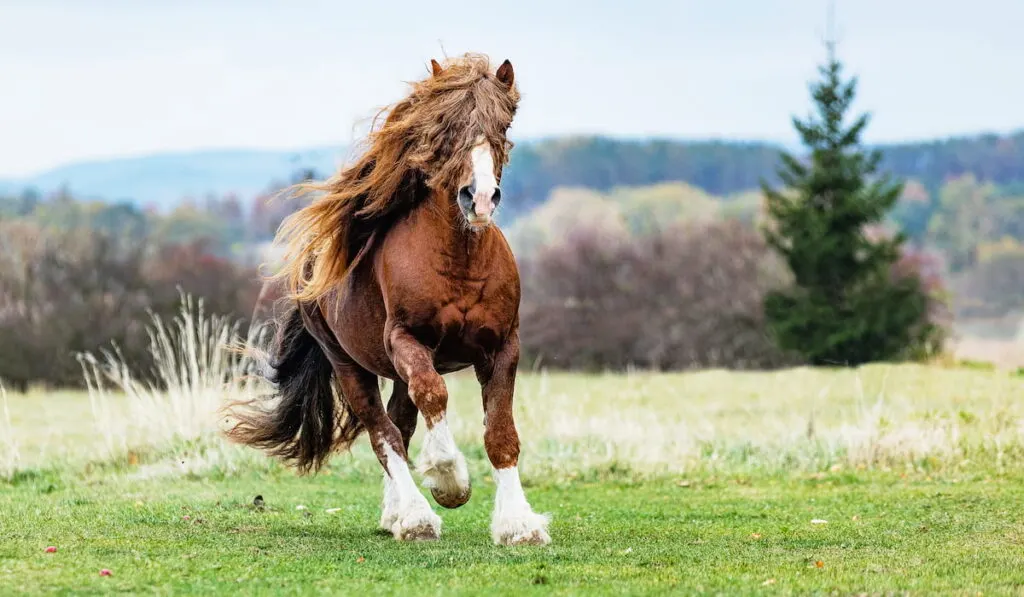
Country of Origin: France
Height: 16 – 18 hands
Weight: 1,600 – 2,400 pounds
Common Colors: Gray or black
These elegant and showy draft horses are commonly seen pulling carriages, performing in circuses, or under saddle and harness for pleasure riding and driving.
Percheron horses are finely built – but strong and heavy. They lack the heavy feathering on the legs of most other draft horses, and have an elegant way of moving, despite their large size.
Dr. Legear was a Percheron gelding (owned by the same man who owned the Clydesdale King LeGear) who stood at 21 hands high and weighed in at 2,995 pounds.
Another massive Percheron/Arabian cross named Morocco was a hit at the 1904 St, Louis World’s Fair – standing at 21.2 hands high and 2,835 pounds.
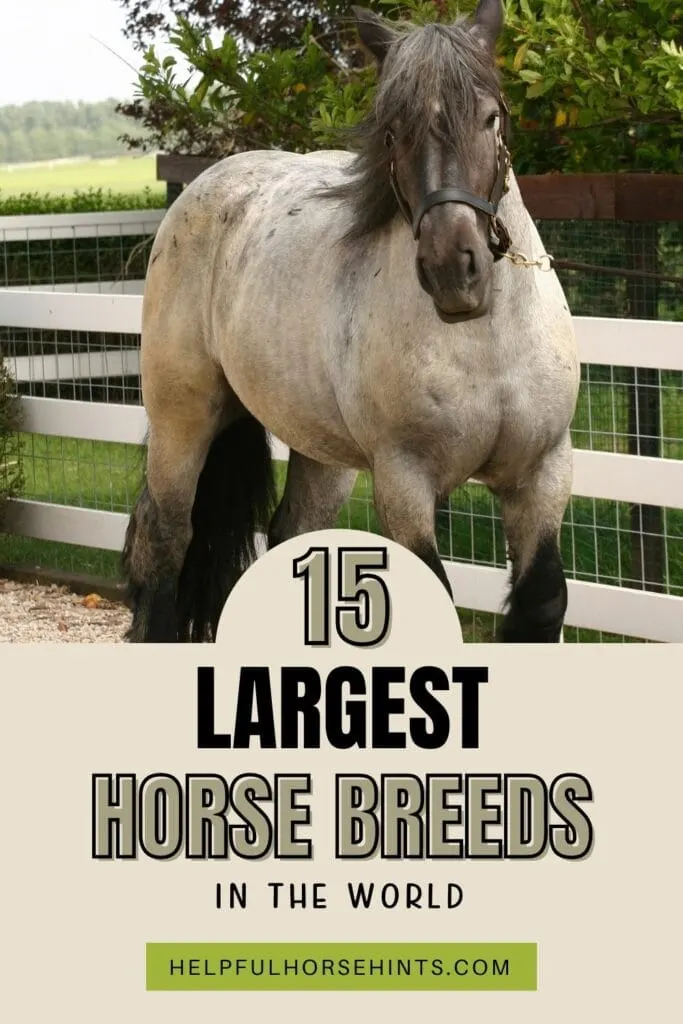
4. Clydesdale
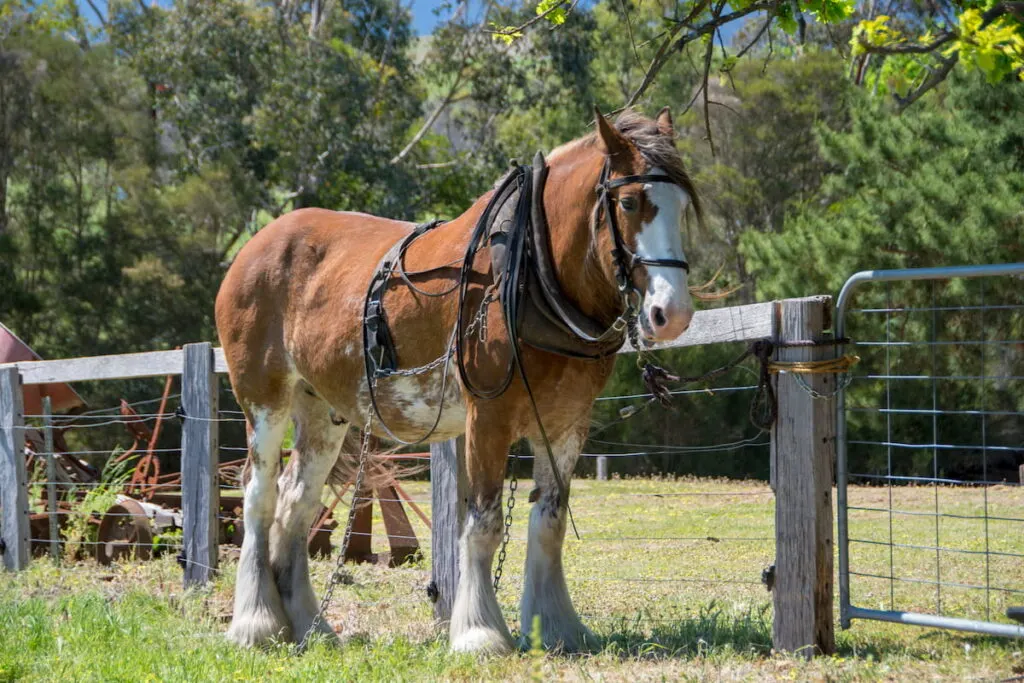
Country of Origin: Scotland
Height: 16.2 – 18 hands
Weight: 1,800 – 2,000 pounds
Common Colors: Bay, brown
Made popular by Budweiser beer commercials, the Clydesdale is a tall handsome horse commonly used for driving and agricultural work.
Males commonly grow beyond 18 hands and 2,200 pounds, and some of the largest horses on record were Clydesdales.
King LeGear, a Clydesdale from St. Louis was colloquially known as “King of the Horses” and “The Giant Horse.” The Clydesdale gelding stood 20 ¼ hands tall and weighed 2,950 pounds.
Remington, a Clydesdale from Texas, previously held the Guinness World Record for the tallest living horse at just over 20 hands.
3. Belgian
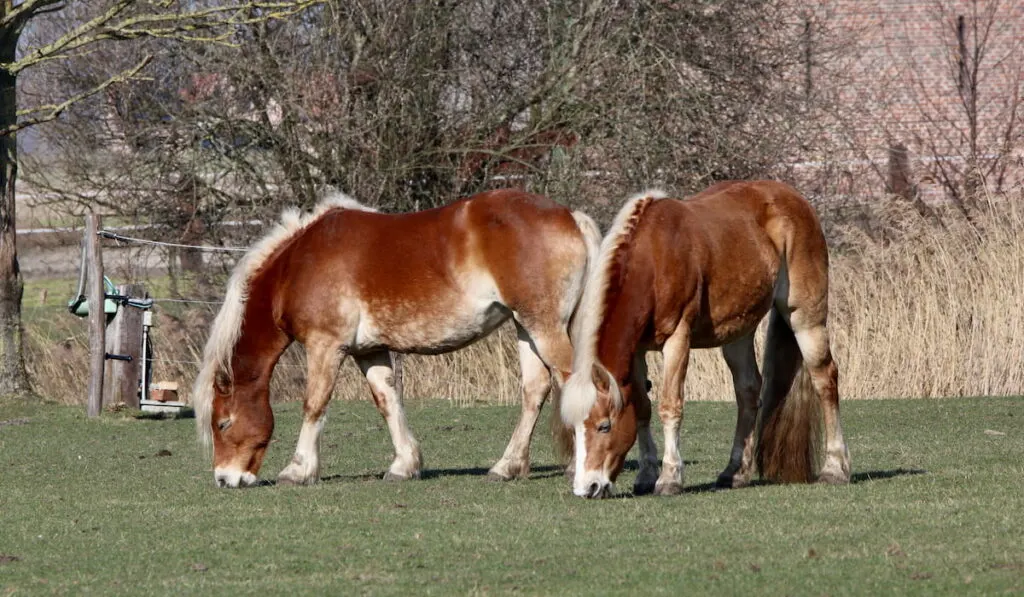
Country of Origin: Belgium
Height: 16 – 18 hands
Weight: up to 2,200 pounds
Colors: Chestnut or sorrel, with white mane and tail
While the Belgian horse in Belgium is heavier and more suited for agricultural work, the elegant American Belgian is fine-boned and strong. A solid carriage and riding horse, the Belgian is popular in the tourism industry and in the show ring.
While the Belgian is known for its heavy build, it also has good gaits and flashy high-stepping trot – necessary traits for a good carriage horse. You’ll often see them hitched to commercial carriages, in a hitch-pulling competition, or under saddle as a pleasure horse in the show ring.
The current Guinness World Record holder for “tallest horse” is a Belgian named Big Jake. He stands at just about 20.5 hands high. Belgians are usually chestnut or sorrel, and have white markings and light feathering on their legs.
2. Brabant
Country of Origin: Belgium
Height: 15.2 – 17 hands
Weight: up to 3,000 pounds
Common Colors: Red bay, bay roan, blue and strawberry roan, dark bay
The heaviest of all the of the Belgian draft horses, the Brabant is massive – often weighing up to 3,000 pounds. Though the American Brabant Association doesn’t distinguish between Belgian horses and Brabant horses, they are phenotypically different.
Also called the Belgisch Trekpaard and the Cheval Trait du Nord, the Brabant is a heavy docile workhorse. Heavily muscled and stocky, they are excellent for agricultural work and have been imported into the US for over 100 years.
However, as the breed continued to flourish in America, the Brabant merged with the American Belgian – a tall, lighter-boned breed that comes almost exclusively in shades of chestnut and sorrel.
1. Shire
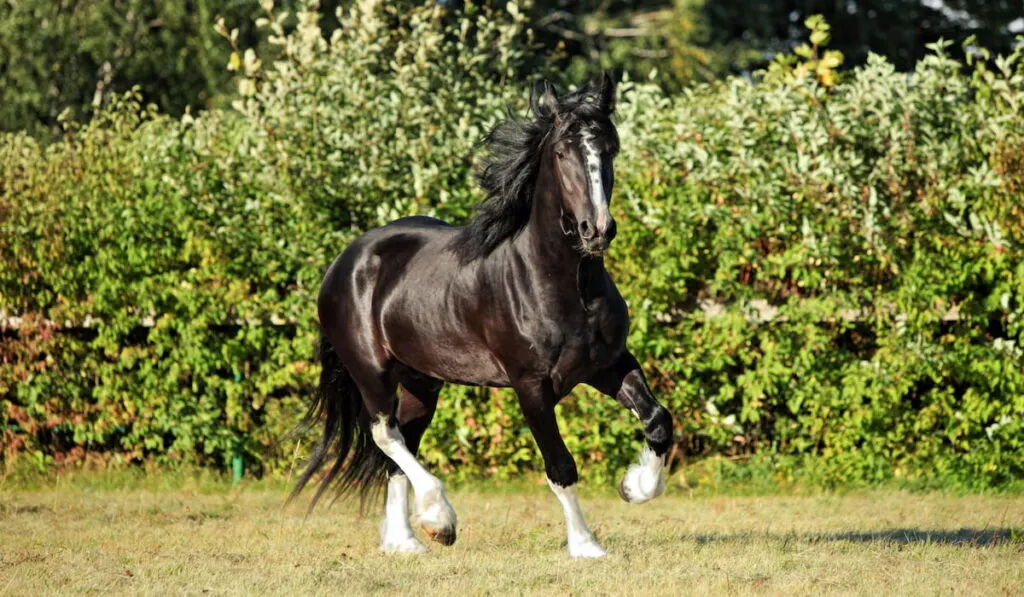
Country of Origin: England
Height: 16.2 – 19 hands
Weight: 1,500 – 2,200 pounds
Common Colors: Black, brown, bay, gray, chestnut
The tallest of all the draft breeds (and second heaviest only to the Brabant), Shire horses often reach 19 hands and above. These heavy draft horses have an elegant way of moving and a quiet disposition. The heavy feathering on their legs protects them from the wet and muddy conditions of the English countryside.
Heavy and strong, Shires are used for logging and other agricultural work. In 1924, a particularly strong Shire named Vulcan was clocked at pulling a 29-ton load (initially by himself!).
The tallest and heaviest horse ever recorded was Sampson, a Shire gelding born in 1846. He was 21.2 ½ hands high (or 86.5 inches at the withers) and weighed over 3,360 pounds at his peak weight. Sampson weighed more than a mid-size sedan!
While most draft horses in the United States today are kept as pleasure and performance horses, other heavy breeds around the world continue to work as stock animals on small farms, or provide meat to communities across Europe and Asia.

